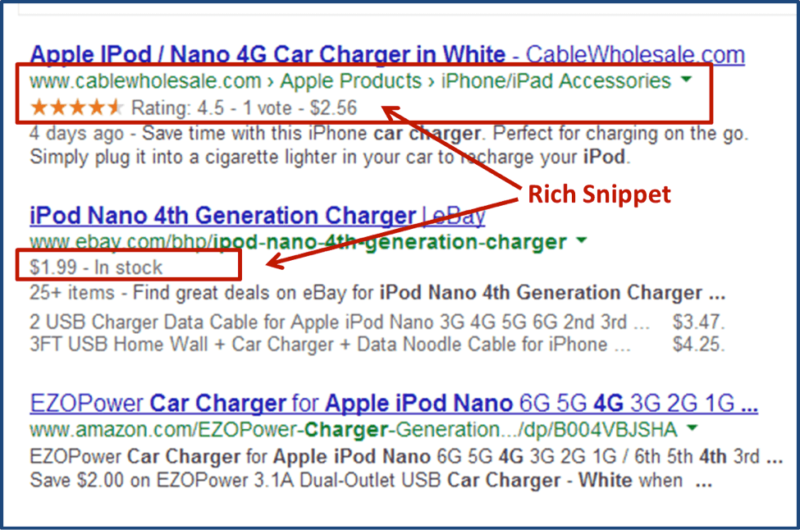4 things you didn’t know about rich snippets
Wondering how to get those enhanced SERP displays? Columnist Pratik Dholakiya shares useful information about rich snippets and structured data to get you started.
Since their launch in 2009, rich snippets have served as a “sneak preview” of Google Search results, adding extra information to a search listing that helps searchers find exactly what they’re looking for.
Depending on the page content, this extra information might include site navigation breadcrumbs, customer reviews, TV and movie information, event information, recipe information, product information and so on.
By marking up webpages using vocabulary from schema.org, webmasters can help their sites become eligible to display rich snippets in search results. While Google does not guarantee that rich snippets will appear for any site, incorporating structured data markup makes it easier for search engines to crawl, parse and display page content.
Despite their having been around for over seven years now, there are still plenty of misconceptions around rich snippets. Following are four facts you should know about them.
1. Rich cards are not rich snippets
Google’s rich cards are often presented as the next step forward for rich snippets, the next evolution. But they’re actually something different, with a different place in the SEO ecosystem.
Rich cards and rich snippets both use structured data markup to produce enhanced SERP displays, presenting page content in a more meaningful and appropriate way to Google Search users. But that doesn’t mean their roles and functions are identical.
Rich cards are presented in a carousel at the top of search results, and at the moment they’re tightly restricted. Where will you see rich cards?
- Mobile search results only
- Search results in English only
- Movie and recipe results only
Rich cards will not always be subject to these limitations, but there will always be limited space in that carousel. Rich cards are there to enhance the mobile user’s search experience by providing a preview of top search results.
Rich snippets are a different animal. They’re applicable to more content types, and they’re displayed inline with ordinary search results. That means even if you’re not in the top handful of search results, rich snippets can help to increase your traffic and make it more targeted. And your site may be eligible for rich snippets even if you’re not in the small group of content types that currently allows rich cards.
2. Rich snippets don’t (directly) affect your rankings
Though it has been hinted that structured markup might one day factor into its ranking algorithm, Google has made it clear that rich snippets currently do not affect site rankings.
However, while structured data markup for rich snippets does not work as a ranking signal, it can generate indirect SEO benefits by making your page more easily indexable and providing more accurate and targeted metadata.
On-page behavioral data (click-through rate, bounce rate, time on site and so forth) is believed to have an impact on rankings — so the more qualified, targeted traffic you get, the better. In other words, higher user engagement with your pages may lead to higher rankings, and therefore more traffic, in a virtuous circle of SEO success.
Rich snippets help you achieve this by pre-qualifying visitors. If my Google search leads me to a SERP with listings that just offer the bare minimum of information, I won’t know whether any given listing matches what I actually want until I click through.
When I visit a site, then realize it’s not relevant and bounce, I’m not pleased. I’m back to search again, so Google’s not pleased, either. And the site I visited now has worse on-site behavior stats because I bounced back to the SERP.
No one is well served by this model.
With rich snippets, your visitors know what you do and can even see social proof like reviews right in the snippet. E-commerce sites, blogs, entertainment sites and others can use rich snippets to pre-qualify traffic, improve the way they serve their users and earn themselves indirect SEO benefits at the same time.
3. Google can disable rich snippets for your sites in some cases
Google loves structured data — so much so that it makes a concerted effort to protect its integrity:
We perform algorithmic and manual quality checks to ensure that structured data meets relevancy standards. In cases where we see structured data that does not comply with these standards, we reserve the right to disable rich snippets for a site in order to maintain a high-quality search experience for our users.
Again, Google is pretty clear about where it stands: Not only will they disable rich snippets created by spammy structured data markup, they might also hit your site with a manual penalty.
So, how do you avoid this?
Ensure that you’re using the appropriate type of structured data markup for your content type. Google displays different rich snippet formats depending on your page content. Google’s Structured Data Testing Tool will show you whether you’re using the right code for your page and give you hints and tips on how to deploy it to better effect.
After that, it’s a question of looking at it from your users’ viewpoint. If you’re using rich snippets to enhance the search experience and pre-qualify traffic, then you should be fine — assuming you don’t slip up technically. If you’re using it as a new place to keyword-stuff, you’re headed for a fall.
4. Google has three tools to help you with structured data for rich snippets
Building out and marking up structured data isn’t always easy. If it’s not your core skill set, you’re not certain that you’ve done it right, or you just want to check up on individual pages’ structured data markup, Google has you covered.
Because it wants to encourage what it regards as best practices, Google offers you a whole lot of support, giving you three free, comprehensive tools to test structured data.
- Structured data report. Google Search Console offers a structured data report that identifies structured data found on your site. This report will help you check which structured data types have errors, drill down to specific errors such as Missing field or Missing best or worst rating by clicking on them to get more insight and detail, and offer advice to fix the markup on your site. It will also verify that the updated markup is correct.
- Data Highlighter. As an alternative to implementing markup, the Data Highlighter tool helps Google understand structured data on your site by allowing you to tag data fields by highlighting them with your mouse. Then Google knows more about your site and can present it better in SERPs through rich snippets.
- Structured Data Testing Tool. Google’s Structured Data Testing Tool helps webmasters develop, test and modify structured markup. You can use the FETCH URL function to test structured data markup that exists on a given URL, or the CODE SNIPPET function to test markup code you’ve developed to see if it passes muster. From here, you can modify the code as needed to address any issues.
Wondering where to start when developing your markup? The Search Gallery contains a gallery of rich snippets and rich cards that can be displayed as a result of properly implemented structured data markup, along with markup templates for each one. The Data Type reference lets you see all the data types you can implement, shows you required and recommended fields and offers examples that load directly in the Structured Data Testing Tool environment.
Conclusion
Rich snippets can give you great visibility when you get your structured data markup right. So make sure you use all the tools Google has given you to your advantage, dig a little into what kind of snippets work for your industry, and you’re well on your way to bettering your organic CTR with a little extra effort.
Opinions expressed in this article are those of the guest author and not necessarily Search Engine Land. Staff authors are listed here.
Related stories
New on Search Engine Land


